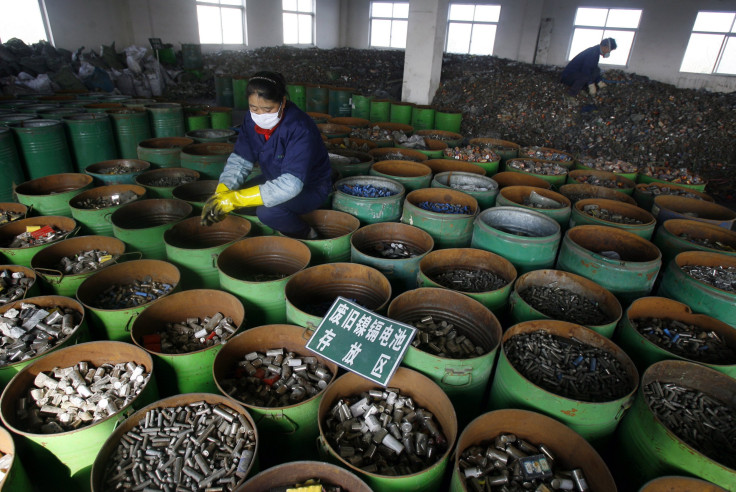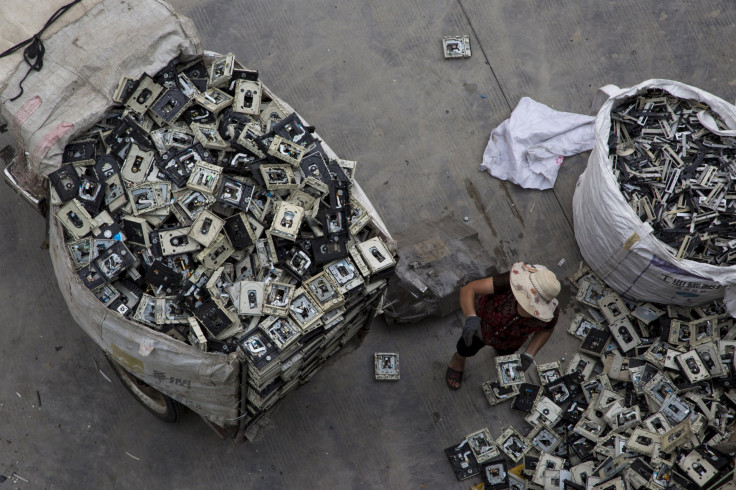Electronic Waste Is Taking Over The World; Here's What New York City Is Doing About It

In the back of my closet, a box filled with discarded electronics awaits an uncertain fate. A small square iPod shuffle rests atop a mountain of USB sticks. Tangles of wires snake around expired batteries. A broken smartphone and ancient 2004 digital camera quietly gather dust.
All of these products contain toxic chemicals that, if thrown into a landfill, could leech into the soil and poison the drinking water. But recycling these responsibly means lugging the box to an electronics store -- which wouldn’t be so difficult, if only I could remember to do it. So there they sit.
As electronic devices proliferate in our lives, so too does the amount of “e-waste” we generate. The mounting problem is pushing cities and companies to search for better recycling solutions. Leading the way is New York City, which already has some of the most ambitious climate-change and clean-energy policies of any U.S. city.
On Wednesday, city officials announced their E-cycleNYC initiative is now serving more than 1 million New Yorkers, or about one-eighth of the city’s population. So far this year, residents have recycled 600,000 pounds (or about 270 metric tons) of electronic waste, and the city is on track to hit 1.5 million pounds (680 metric tons) by the end of 2015.

But the initiative, while significant, is still just a drop in the bucket compared to all e-waste accumulating around the globe.
The world tossed out nearly 42 million metric tons of e-waste in 2014 alone -- roughly the weight of 650 aircraft carriers, the United Nations University estimates. The total includes everything from household appliances like toaster ovens and vacuum cleaners, to larger hauls such as TV sets and dishwashers and even newer technologies like drones and rooftop solar panels.
Only one-sixth of the world’s e-waste was properly recycled or reused last year, according to the U.N. organization. The remainder ended up in landfills or, just as bad, in giant e-waste dumps in China, Ghana and India. Residents there pick off the valuable gold, iron and copper for resale, exposing themselves to health-threatening mercury, lead and cadmium in the process.
New York's sanitation officials say they hope other cities will replicate the E-cycleNYC initiative, helping reduce the amount of chemical-laden electronics that end up in the trash or slums.
“The E-cycleNYC program represents the most innovative and comprehensive electronics recycling service offered in the nation,” Kathyrn Garcia, the New York City sanitation commissioner, said in a Wednesday statement.
The program launched in late 2013. Earlier this year, the city passed a ban on throwing away electronics with other garbage. E-cycleNYC allows building owners with 10 or more apartment units to sign up to receive an e-waste recycling bin. More than 2,500 such buildings have enrolled in the program so far. Residents carry their telephones, printers and assorted electronic knickknacks into the building’s basement, just like they would their garbage or plastic and paper recycling.
Electronic Recyclers International (ERI), a private company contracted by the city, then collects the e-waste and transfers it to the company’s hub in Saddle Brook, New Jersey. From there, the electronics move to ERI’s recycling facility in Holliston, Massachusetts, where glass pieces are dismantled and a custom-built shredder separates the plastic and metal. Those materials are sold to smelters and manufacturers, which use the recycled parts to make car doors, airplane wings -- or even new smartphones.
Globally, all the e-waste thrown out last year represented some $52 billion of potentially reusable resources, including enormous quantities of iron, copper and gold, as well as sizable sums of silver, aluminum and palladium, United Nations University found.

John Shegerian, chief executive and chairman of ERI, said his Fresno, California, company has e-recycling programs in about 200 other U.S. cities, including Boston and Los Angeles. When ERI first formed in April 2005, the company collected about 10,000 pounds of e-waste a month. A decade later, it now takes in around 25 million pounds a month.
Shegerian attributed the staggering growth to three factors. First, Americans are simply more concerned about recycling and environmental sustainability than they were even 10 years ago, he said. Second, security-conscious government agencies and individuals are worried about dumping hard drives and servers full of sensitive data, including passwords and Social Security numbers.
And third, the constant stream of new products and continuous iterations of existing models is expanding the waste stream. Shegerian said ERI is now recycling drones, smart wristbands, robots, solar panels and even Nest thermostats at its eight U.S. facilities. “The products are getting smaller and more interesting,” he said by phone. “That’s only going to grow. And that stuff still has to be recycled.”

Shegerian said New York City’s program could inspire other municipalities to tackle their own deluge of local electronic waste. “Other cities are going to look at this very carefully in the months and years to come,” he said.
But not all New Yorkers can benefit from the Big Apple’s program just yet. My building in the borough of Brooklyn has just two apartments, so it doesn’t fit the bill for an e-waste recycling bin. Perhaps I should get a bigger box for my Flip cam and outdated phone charger.
© Copyright IBTimes 2025. All rights reserved.





















